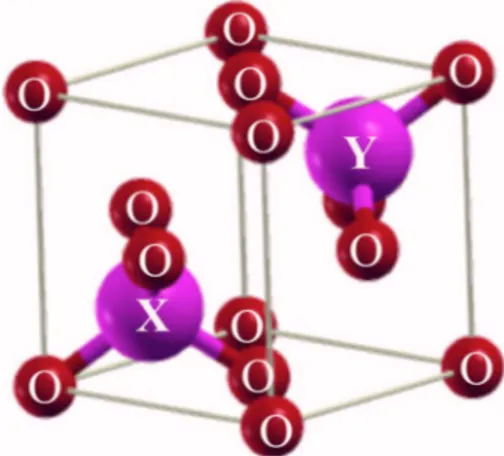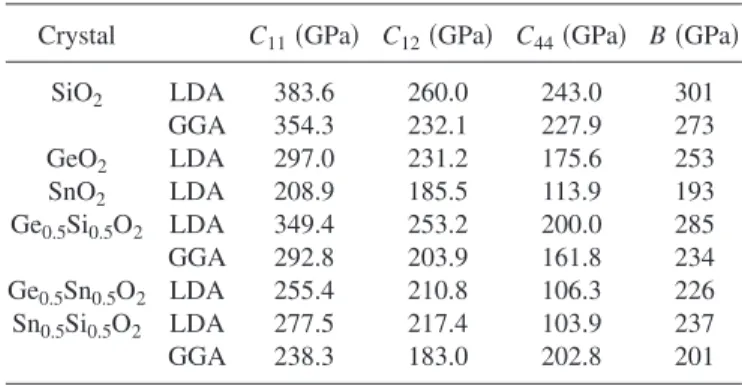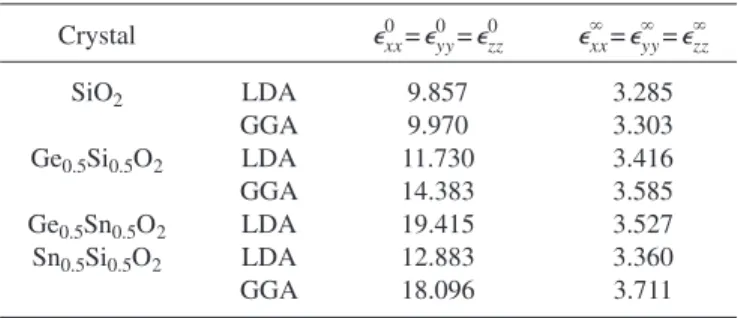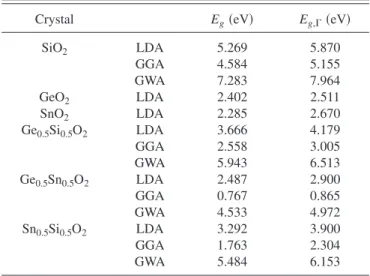High dielectric constant and wide band gap inverse silver oxide phases of the ordered ternary
alloys of SiO
2, GeO
2, and SnO
2C. Sevik*and C. Bulutay†
Department of Physics, Bilkent University, Bilkent, Ankara, 06800, Turkey
共Received 19 June 2006; revised manuscript received 7 September 2006; published 15 November 2006兲
High dielectric constant and wide band gap oxides have important technological applications. The crystalline oxide polymorphs having lattice constant compatibility to silicon are particularly desirable. One recently reported candidate is the inverse silver oxide phase of SiO2. A first-principles study of this system together with its isovalent equivalents GeO2and SnO2as well as their ternary alloys is performed. Within the framework of density functional theory both the generalized gradient approximation and local density approximation共LDA兲 are employed to obtain their structural properties, elastic constants, and electronic band structures. To check the stability of these materials, phonon dispersion curves are computed which indicate that GeO2and SnO2have negative phonon branches whereas their ternary alloys Si0.5Ge0.5O2, Si0.5Sn0.5O2, and Ge0.5Sn0.5O2 are all stable within the LDA possessing dielectric constants ranging between 10 and 20. Furthermore, the lattice constant of Si0.5Ge0.5O2is virtually identical to the Si共100兲 surface. The GW band gaps of the stable materials are computed which restore the wide band gap values in addition to their high dielectric constants.
DOI:10.1103/PhysRevB.74.193201 PACS number共s兲: 61.50.Ah, 62.20.Dc, 63.20.Dj, 71.15.Mb
High dielectric constant and wide band gap oxides are of general interest for the next-generation gate oxides for silicon-based electronics1 and also as host matrices for non-volatile flash memory applications.2Amorphous oxides have been generally preferred as they are good glass formers which tend to minimize the number of dangling bonds at the interface. In this respect, polycrystalline oxides are undesir-able as the grain boundaries cause higher leakage currents and possible diffusion paths for dopants.1On the other hand, crystalline oxide grown epitaxially on silicon3can be favor-able as it will result in high interface quality provided that it is lattice-matched to Si.
Very recently, Ouyang and Ching4 have reported a high-density cubic polymorph of SiO2in the inverse Ag2O struc-ture, named by them as the i phase, possessing both a high dielectric constant, as in stishovite phase, and lattice constant compatibility to the Si共100兲 face, which makes it very attrac-tive for electronic applications. In this computational work, we continue this search for the crystalline high dielectric constant oxides with the i phases of GeO2and SnO2as well as their ordered ternary alloys with SiO2. This pursuit is in line with the International Technology Roadmap for Semi-conductors where computational synthesis of novel high di-electric materials is emphasized.5 We employ the well-established ab initio framework based on density functional theory within the generalized gradient approximation and lo-cal density approximation using pseudopotentials and a plane-wave basis.6
The unit cell for the ordered ternary alloy X0.5Y0.5O2 in the inverse Ag2O structure is shown in Fig.1. Structural and electronic properties of the i-phase structures under consid-eration have been calculated within density functional theory,6using the plane-wave basis pseudopotential method as implemented in theABINITcode.7The results are obtained under the generalized gradient approximation共GGA兲 and lo-cal density approximation 共LDA兲 where for the exchange-correlation interactions we use the Teter-Pade parametrization,8 which reproduces the Perdew-Zunger
parametrization9 共which reproduces the quantum Monte Carlo electron gas data of Ceperley and Alder10兲. We tested the LDA results under two different norm-conserving Troullier- Martins11-type pseudopotentials, which were gen-erated by Khein and Allan 共KA兲 and Fritz Haber Institute 共FHI兲; for either set, the d electrons were not included in the valence configuration. Our calculated values for these two types of pseudopotentials were very similar. In the course of both GGA and LDA computations, the plane-wave energy cutoff and k-point sampling were chosen to assure a 0.001 eV energy convergence for all i-phase crystals. In the case of SiO2this demands a 130-Ry plane-wave energy cut-off and 10⫻10⫻10 k-point sampling. Phonon dispersions and phonon density of states were computed by the PHON
program12 using a 2⫻2⫻2 supercell of 48 atoms to con-struct the dynamical matrix. The required forces were ex-tracted fromABINIT. The corrected band-gap values are com-puted by obtaining self-energy corrections to the DFT Kohn-Sham eigenvalues in the GW approximation.13 All parameters used during the GW calculation were chosen to assure a 0.001 eV energy convergence.
FIG. 1. 共Color online兲 Ball and stick model of the
i-phase-ordered ternary alloy X0.5Y0.5O2. PHYSICAL REVIEW B 74, 193201共2006兲
Using XO2 and X0.5Y0.5O2 as the generic notation, the O -X-O and O-Y-O bond angles are 109.47° and the X-O-X and X-O-Y bond angles are 180° according to the crystal con-struction of this cubic i phase 共cf. Fig. 1兲. Other structural information such as the lattice constants and bond lengths of all i-phase crystals are listed in TableI. The Si共100兲 surface lattice constant is about 3.83 Å; therefore, according to LDA results Si0.5Ge0.5O2 is of particular interest as it can be epi-taxially grown on Si without any strain. According to our
well-converged calculations Si0.5Ge0.5O2 has a lower total energy compared to both SiO2 and GeO2, the latter itself being unstable as will be shown later; this can be taken as some indication of immunity to the phase separation of this ternary alloy into its binary compounds.
The LDA and GGA results of the three independent elas-tic constants and bulk modulus for all crystals are tabulated in Table II. An important concern is the stability of these cubic phases. The requirement of mechanical stability on the elastic constants in a cubic crystal leads to the following constraints: C11⬎C12, C11⬎0,C44⬎0, and C11+ 2C12⬎0. The elastic constants calculated by both the LDA and GGA
TABLE I. First-principles LDA and GGA structural data for
i-phase crystals.
Crystal a共Å兲 Density 共g/cm3兲 x-O 共Å兲 y-O 共Å兲
SiO2 LDA 3.734 3.830 1.617 GGA 3.801 3.633 1.646 GeO2 LDA 3.916 5.781 1.696 GGA 4.053 5.215 1.755 SnO2 LDA 4.180 6.864 1.808 GGA 4.452 5.671 1.928 Ge0.5Si0.5O2 LDA 3.836 4.843 1.697 1.625 GGA 3.923 4.528 1.762 1.635 Ge0.5Sn0.5O2 LDA 4.042 6.416 1.688 1.813 GGA 4.250 5.522 1.748 1.932 Sn0.5Si0.5O2 LDA 3.970 5.590 1.818 1.620 GGA 4.114 5.015 1.935 1.628
TABLE II. Elastic constants and bulk modulus for each crystal.
Crystal C11共GPa兲 C12共GPa兲 C44共GPa兲 B 共GPa兲
SiO2 LDA 383.6 260.0 243.0 301 GGA 354.3 232.1 227.9 273 GeO2 LDA 297.0 231.2 175.6 253 SnO2 LDA 208.9 185.5 113.9 193 Ge0.5Si0.5O2 LDA 349.4 253.2 200.0 285 GGA 292.8 203.9 161.8 234 Ge0.5Sn0.5O2 LDA 255.4 210.8 106.3 226 Sn0.5Si0.5O2 LDA 277.5 217.4 103.9 237 GGA 238.3 183.0 202.8 201
FIG. 2. LDA phonon dispersions and the phonon DOS共states/eV cell兲 of the stable crystals 共a兲 SiO2,共b兲 Ge0.5Si0.5O2,共c兲 Ge0.5Sn0.5O2, and共d兲 Si0.5Sn0.5O2.
BRIEF REPORTS PHYSICAL REVIEW B 74, 193201共2006兲
shown in TableIIsatisfy these stability conditions. Further-more, we compute the LDA and GGA phonon dispersion curves of these structures using thePHONprogram.12First, to verify the validity of the results of the PHON program we compute the phonon dispersions of the SiO2 and GeO2 by using both PHON and the ANADDB extension of the ABINIT
code.7 There exists good agreement between two calcula-tions. Next, we calculate the phonon dispersions of the all i-phase crystals via the PHONprogram with forces obtained
from the LDA and GGA. It is observed that SiO2is at least
locally stable whereas GeO2and SnO2contain negative pho-non branches which signal an instability of these phases. As for their alloy Ge0.5Sn0.5O2, according to the LDA this ma-terial is stable whereas within the GGA it comes out as un-stable. For the stable structures the LDA phonon dispersions and the associated phonon density of states共DOS兲 are shown in Fig.2.
For the stable systems, the static and high-frequency di-electric constants are listed in TableIII. The static dielectric constants falling in the range between 10 and 20 suggest that these are moderately high dielectric constant crystals. It can be observed that the GGA yields systematically higher val-ues for the dielectric constants of these structures. Employ-ing KA pseudopotentials, the LDA band structure for the crystals is displayed along the high-symmetry lines in Fig.3 including the electronic DOS. The widths of the valence bands get progressively narrowed from Fig.3共a兲–3共d兲—i.e., from SiO2to Sn0.5Si0.5O2. For all of the i-phase crystals un-der consiun-deration including the unstable ones the conduction band minima occur at the⌫ point whereas the valence band maxima are located at R point making them indirect band gap semiconductors. As tabulated in TableIV, the direct the band gap values are only marginally above the indirect band
TABLE III. LDA and GGA dielectric permittivity tensor for the stable crystals. Crystal ⑀xx0=⑀yy0 =⑀0zz ⑀xx⬁=⑀yy⬁=⑀zz⬁ SiO2 LDA 9.857 3.285 GGA 9.970 3.303 Ge0.5Si0.5O2 LDA 11.730 3.416 GGA 14.383 3.585 Ge0.5Sn0.5O2 LDA 19.415 3.527 Sn0.5Si0.5O2 LDA 12.883 3.360 GGA 18.096 3.711
FIG. 3. LDA electronic band structure and DOS共states/eV cell兲 of i-phase 共a兲 SiO2, 共b兲 Ge0.5Si0.5O2,共c兲 Ge0.5Sn0.5O2, and 共d兲 Sn0.5Si0.5O2.
BRIEF REPORTS PHYSICAL REVIEW B 74, 193201共2006兲
gap values. Again the GGA systematically yields narrower band gaps compared to the LDA.
A renown artifact of the LDA is that for semiconductors and insulators band gaps are underestimated.6 In this work, the corrected band-gap values are also provided by the GW approximation. As there are different GW implementations we briefly highlight the particular methodology followed in theABINITcode. First, a converged ground-state calculation 共at fixed lattice parameters and atomic positions兲 is done to get a self-consistent density and potential and Kohn-Sham eigenvalues and eigenfunctions at the relevant band extrema k points as well as on a regular grid of k points. Next, on the basis of these available Kohn-Sham data, the independent-particle susceptibility matrix 0 is computed on a regular grid of q points for at least two frequencies 共usually, zero frequency and a large pure imaginary frequency—on the
or-der of the plasmon frequency, a dozen of eV兲. Finally, the random phase approximation susceptibility matrix, the di-electric matrix⑀, and its inverse⑀−1 are computed. On this basis, the self-energy⌺ matrix element at the given k point is computed to derive the GW eigenvalues for the target states at this k point. Note that this GW correction is achieved as a one-shot calculation共i.e., no overall self-consistency兲; hence, our results technically correspond to G0W0 which has been the standard approach as originally proposal by Hedin.14The GW correction as can be observed from TableIVrestores the wide band gap values; this feature is essential for these ma-terials to provide sufficient confinement to carriers of the narrow band gap semiconductors such as silicon.
We have also considered the i phase of PbO2 which turned out to be unstable and hence its ab initio data are not included. In this work, we do not consider the thermody-namic stability of these i-phase oxides. However, for techno-logical applications rather than bulk systems the epitaxial growth conditions become more critical.15 A promising di-rection can be a finite-temperature investigation16 of these i-phase isovalent structures on Si共100兲 surfaces using a large number of monolayers.
This first-principles study suggests that the i phases of GeO2and SnO2are unstable whereas SiO2, Si0.5Ge0.5O2, and Si0.5Sn0.5O2 are particularly promising due to their high di-electric constants as well as wide band gaps as restored by the GW correction. Moreover, they are lattice-matched to the Si共100兲 face, especially for the case of Si0.5Ge0.5O2. We be-lieve that these findings can further boost research on crys-talline oxides.
This work has been supported by the European FP6 Project SEMINANO under Contract No. NMP4 CT2004 505285. We would like to thank O. Gülseren, R. Eryiğit, T. Gürel, D. Çakır, and T. Yıldırım for their useful advice. The computations were performed in part at the ULAKBİM High Performance Computing Center.
*Electronic address: sevik@fen.bilkent.edu.tr †Electronic address: bulutay@fen.bilkent.edu.tr
1J. Robertson, Rep. Prog. Phys. 69, 327共2006兲.
2D. W. Kim, T. Kim, and S. K. Banerjee, IEEE Trans. Electron Devices 50, 1823共2003兲; M. She and T. J. King, ibid. 50, 1934 共2003兲.
3Z. Yu, Y. Liang, C. Overgaard, X. Hu, J. Curless, H. Li, Y. Wei, B. Craigo, D. Jordan, R. Droopad, J. Finder, K. Eisenbeiser, D. Marshall, K. Moore, J. Kulik, and P. Fejes, Thin Solid Films
462, 51共2004兲.
4L. Ouyang and W. Y. Ching, Phys. Status Solidi B 242, R64 共2005兲.
5The latest edition of the ITRS roadmap can be found at http:// public.itrs.net
6R. M. Martin, Electronic Structure共Cambridge University Press, Cambridge, England, 2004兲.
7X. Gonze, J. M. Beuken, R. Caracas, F. Detraux, M. Fuchs, G. M.
Rignanese, L. Sindic, M. Verstraete, G. Zerah, F. Jollet, M. Tor-rent, A. Roy, M. Mikami, P. Ghosez, J. Y. Raty, and D. C. Allan, Comput. Mater. Sci. 25, 478共2002兲.
8S. Goedecker, M. Teter, and J. Hutter, Phys. Rev. B 54, 1703 共1996兲.
9J. P. Perdew and A. Zunger, Phys. Rev. B 23, 5048共1981兲. 10D. M. Ceperley and B. J. Alder, Phys. Rev. Lett. 45, 566共1980兲. 11N. Troullier and J. L. Martins, Solid State Commun. 74, 613
1990; Phys. Rev. B 43, 1993共1991兲; 43, 8861 共1991兲. 12D. Alfè, Computer code
PHON1998. Program available at http://
chianti.geol.ucl.ac.uk/~dario/
13W. G. Aulbur, L. Jonsson, and J. W. Wilkins, Solid State Phys.
54, 1共2000兲.
14L. Hedin, Phys. Rev. 139, A796共1965兲.
15K. J. Hubbard and D. G. Schlom, J. Mater. Res. 11, 2757共1996兲. 16A. Pasquarello, M. S. Hybertsen, and R. Car, Nature共London兲
396, 58共1998兲.
TABLE IV. Indirect共Eg兲 and direct 共Eg,⌫兲 band gaps for each
i-phase crystal within the LDA, GGA, and for the stable structures
the GW approximation共GWA兲.
Crystal Eg共eV兲 Eg,⌫共eV兲
SiO2 LDA 5.269 5.870 GGA 4.584 5.155 GWA 7.283 7.964 GeO2 LDA 2.402 2.511 SnO2 LDA 2.285 2.670 Ge0.5Si0.5O2 LDA 3.666 4.179 GGA 2.558 3.005 GWA 5.943 6.513 Ge0.5Sn0.5O2 LDA 2.487 2.900 GGA 0.767 0.865 GWA 4.533 4.972 Sn0.5Si0.5O2 LDA 3.292 3.900 GGA 1.763 2.304 GWA 5.484 6.153
BRIEF REPORTS PHYSICAL REVIEW B 74, 193201共2006兲



